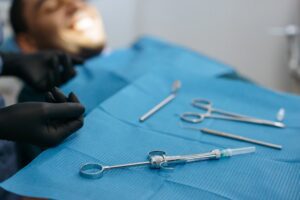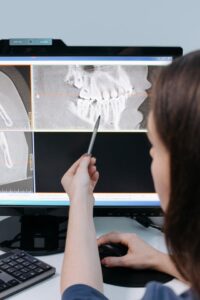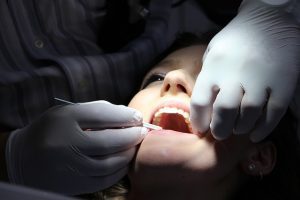Dental bone grafting is exactly what it sounds like; it’s a process of supplementing bone in the mouth/jaw with a graft of your own bone, donor bone, or a boney material. This is a process oral surgeons often use in wisdom tooth extractions or when a patient needs more bone to stabilize a dental implant. There are several types of dental bone grafting oral surgeons use, and each has advantages and disadvantages.
At Wilmington Oral Surgery, we often use PRF and Dentin bone grafting, a holistic process of using the patient’s own bone material for the dental bone graft, and then supporting the supplemented jaw bone with platelet-rich fibrin for optimal healing. This is especially important for the healing process prior to receiving a dental implant. But what does that mean? Let’s get into more detail:
Types of Jaw Bone Grafting for Dental Implants
Medicine constantly strives to improve on available technologies for supplementing the body’s structures and healing processes. The idea of each new development is that (1) the closer the source of the graft is to the patient’s actual tissue, the better, and (2) techniques that spur the patient’s body to create new bone cells are superior to those that don’t. These factors are especially important in oral and maxillofacial contexts because of how important proper facial structure and function is to quality of life.
The ideal dental bone graft for holistic tooth replacement will have three major characteristics:
- Osteogenic: the graft material itself supplies cells that generate bone formation. These cells are called osteoblasts.
- Osteoinductive: the graft material encourages stem cells from neighboring blood and tissue to become osteoblasts.
- Osteoconductive: the graft material is just a scaffolding to guide the osteoblasts to the site that needs rebuilt/supplemented.
The three major reasons we recommend augmenting the jaw with a graft are to:
- Rebuild bone around teeth that have lost bone support due to periodontal disease. This can help to stabilize the teeth and prevent them from falling out.
- Create bone ridges in the jawbone to support dental implants. Dental implants are artificial teeth that are anchored to the jawbone.
- Fill in defects in the jawbone that are caused by facial trauma or surgery.
Different types of dental bone grafting include:
- Autograft: the graft source is the patient’s own tissue.
- Allograft: the graft source is human donor tissue.
- Alloplast: the graft source is synthetic material.
- Xenograft: foreign (xeno) tissue is used for the graft material, usually bovine (cow) in this context.
Autograft technology is superior to the others because it uses the patient’s own biologic materials to regenerate bone. Since the graft isn’t foreign, adverse reactions are rare, and since the graft isn’t synthetic, it actually prompts the body to fix itself, restoring not only bone tissue but the function and blood supply as well. PRF and dentin autografting are two main ways to autograft, and are best used in tandem.
Why We Use PRF + Dentin Grafting at Wilmington Oral Surgery
Our oral surgeon is focused on holistic tooth replacement, meaning if there’s a way to heal and improve a patient’s mouth/jaw without synthetic materials or multiple invasive procedures, we find it. We often use PRF and dentin autografting at our practice for this reason. What does that mean?
Platelet-Rich-Fibrin Supports Post-Graft Integration with the Jaw
“PRF” is platelet-rich fibrin. The oral surgeon extracts the patient’s blood and puts it in a centrifuge to extract the platelets and fibrin from the blood. This creates a solution with a high concentration of platelets, which contain growth factors that stimulate healing (read: the generation of new cells).
This solution is then combined with the grafting material to make a material oral and maxillofacial surgeons refer to as “sticky bone.” This graft lasts about two weeks. Because bone is the slowest tissue regarding healing and growth, PRF is best used with dentin autografting.
Dentin Bone Grafts Offer Holistic Improvements to Traditional Dental Grafts
Dentin is the material that makes up your inner tooth. Dentin autografting is amazing because we can literally make the dental bone graft in the office in less than 10 minutes using either the patient’s or a donor’s tooth. An extracted tooth (or teeth) is stripped, ground very finely, and then used as the grafting material.
Dentin is really similar to bone, and because a live tooth is used, the graft itself contains live cells that encourage the surrounding bone and tissue to grow with the graft. Because of how this type of dental bone grafting works, a tooth that’s had a root canal can’t be used, because it’s essentially dead. However, we can use teeth that are damaged or decayed – we just remove the damage and decay before we process it. As long as the root and nerve of the extracted tooth were intact, meaning there is live blood supply to the tooth, almost any live tooth can be used.
Dentin autografting isn’t just holistic; it’s basically biological recycling. These grafts last much longer than PRF, so PRF is used for short-term stimulation of the body’s healing program, and the dentin stays for the long-term healing process.
Our oral surgeon prefers this process of dental bone grafting when possible because the healing time is the shortest and the bone regrowth and regeneration is most effective. We understand that oral surgeries of any kind are unpleasant; so the less risk of complications and the faster the healing time, the better.
Medicine that is patient-focused and patient-sourced, especially when dealing with the structures of the jaw and face, is superior, which is why we use this type of dental bone grafting. Dentin grafting is just one of the ways we serve Cincinnati patients with holistic oral surgery and post-surgery pain management. Learn more about Wilmington Oral Surgery’s Holistic Care and schedule a consultation with our oral surgeon for more information.










